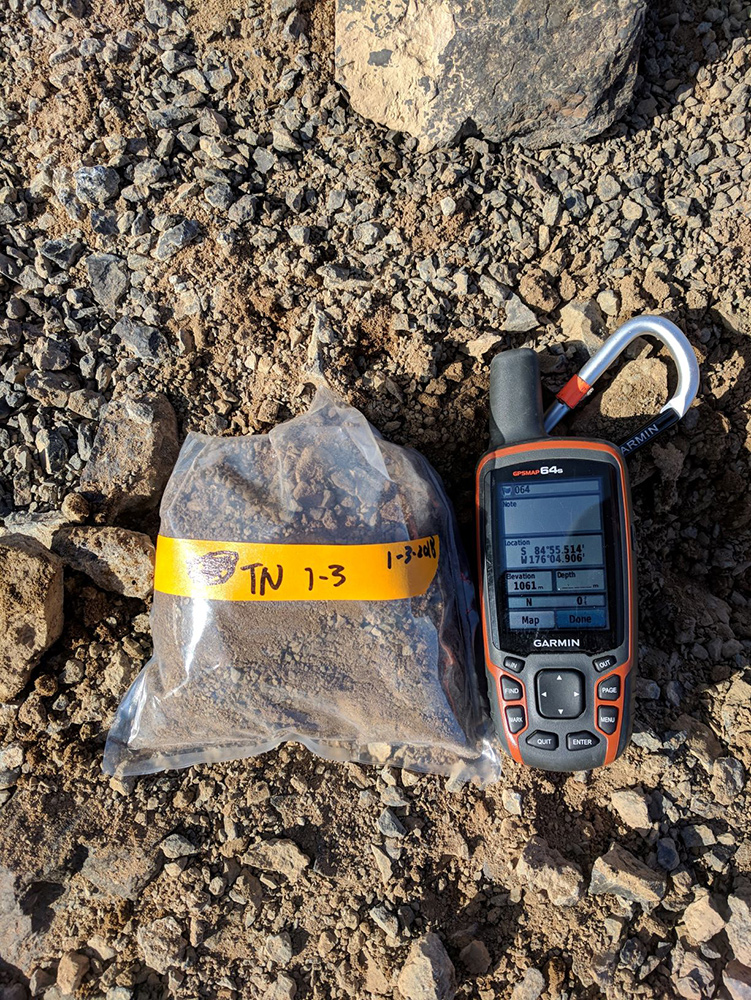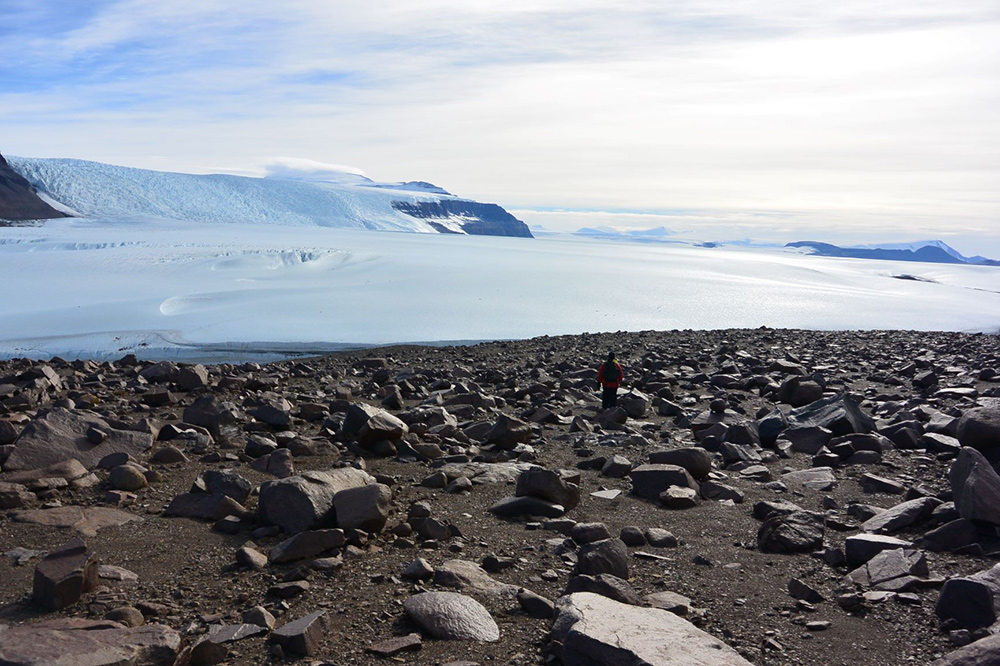Coldest, Driest, Saltiest Antarctic Soils Might be Inhospitable to LifeResearchers Zero in on the Limits of What Life Can ToleratePosted August 23, 2021
Some Antarctic soils might be the only environments on Earth microbes can't colonize, a finding that goes against scientists' expectations of our planet's habitability. 
Photo Credit: Noah Fierer
A bag of collected soil from one of the sampling sites, along with a GPS unit used to record the latitude, longitude, and elevation of the sample.
Most scientists assume microbes can inhabit every environment on Earth, given enough time. After all, microbes are found aplenty in hellishly hot hydrothermal vents on the seafloor, in the acidic hot springs of Yellowstone National Park, and even in Antarctica's McMurdo Dry Valleys, one of the driest places on Earth. But new research finds that some of the coldest, saltiest, and driest soils in the Transantarctic Mountains show no signs of viable microbial life. The researchers can't definitively say these soils are completely sterile, but if life is there, it's below the limits of what scientists can detect. "Microbes can basically tolerate anything, and yet here we have evidence that, oh, maybe that's not always true," said Noah Fierer, a microbial ecologist at the University of Colorado Boulder and co-author of a new study detailing the findings. This is the first time, to the authors' knowledge, that soil samples have been found to be devoid of microbial life. Scientists often talk about the limits of life on the extreme heat end of the temperature spectrum, so the researchers were intrigued by the finding that there may be a lower temperature limit to what life can withstand. "To see a different set of environmental conditions – in this case, the cold, salty, dry – restricting microbial life, is, in my opinion, really interesting," said Nick Dragone, lead author of the new study and also a microbial ecologist at the University of Colorado Boulder. The findings help scientists hone in on what conditions make an environment inhospitable to even the most resilient forms of life, and place limits on where life might be found on other planets. Many scientists hold out hope for finding microbial life on Mars, which is also an extremely cold, dry, and salty place. These new results suggest life might not survive there at all. "If we can assume these soils in Antarctica are kind of an analog for a study of Mars, I think we have to be prepared for the assumption that there just may be nothing there," Fierer said. Sifting Through SoilMicroorganisms are the most abundant form of life on Earth and are found nearly everywhere. They were the first forms of life to evolve and make up about 15% of all biomass found on the planet today. 
Photo Credit: Noah Fierer
Team members Byron Adams, Ian Hogg, and Geoff Schellens at the top of Mount Speed in the Shackleton Glacier valley.
Because microbes inhabit nearly every stable environment on Earth (unstable environments, like active lava flows, are often microbe-free), scientists are naturally curious as to whether there are any places on Earth microbes can't survive. If any environments are inhospitable to microbes, they are likely to be in Antarctica, which is the highest, driest, coldest, and windiest continent. Soils typically host diverse communities of microbes, but past research has shown Antarctic soils harbor some of the lowest concentrations of microbial life on the entire planet. It's difficult to prove a complete absence of life, but scientists suspected there might be places in Antarctica where life might be below the threshold of what humans can reliably detect. From December 2017 to January 2018, Fierer and a team of researchers set out to test whether there are any Antarctic soils where life is undetectable and to define the environmental conditions that might restrict the growth of life. The team collected more than 200 soil samples at 10 different sites from the Shackleton Glacier region in the Transantarctic Mountains. They sampled soils across a range of elevations and conditions – from a few hundred feet above sea level to more than 7,000 feet – to get a sense of what microbes can tolerate in terms of cold, salt levels, and availability of water. After bringing the soil samples back to the United States, the researchers looked for the presence of microbes in several ways. They first looked for traces of DNA, the molecule forming the building block of life. They also applied slurries of soil samples to petri dishes to see if microbial colonies grew in the lab. Finally, they measured whether the samples were consuming glucose and generating energy. The Limits of LifeThe researchers found that, in general, soils at higher elevations and further inland were drier, saltier, and had fewer microbes. To their surprise, about one-fifth of all the samples they collected showed no signs of viable microbial life at all. "The environmental conditions that are getting more challenging as you increase in elevation in the Shackleton Glacier Valley are restricting microbial life to a point where we can't detect them using these widely used methods," Dragone said. "And that pattern itself is really interesting." Microbes are found in other places of the world that are saltier and at higher elevations, so it's likely a combination of extreme conditions prevents microbes from existing in these soils. "Each one of those individually, microbes can tolerate," Fierer said. "They can tolerate super low temperatures. They can tolerate high salt concentrations. They can tolerate lack of liquid water. But I think these soils where we see no detectable microbes, it's kind of a combination of all three. You're hitting them with the hat trick of challenges." The next question, according to Fierer, is to look at the samples where there were microbes present and figure out how they tolerate the punishing conditions. Of the microbes they detected in the study, the majority were fungi, which suggests fungi might be most adapted to harsh environments. "There are microbes in some of those soils that are close to those limits of life," he said. "How do they survive in there? How are they dealing with this environment?" This research was supported by the National Science Foundation, which manages the U.S. Antarctic Program. NSF-funded research in this story: Noah Fierer, University of Colorado Boulder, Award No. 1341629. |
"News about the USAP, the Ice, and the People"



For USAP Participants |
For The Public |
For Researchers and EducatorsContact UsU.S. National Science FoundationOffice of Polar Programs Geosciences Directorate 2415 Eisenhower Avenue, Suite W7100 Alexandria, VA 22314 Sign up for the NSF Office of Polar Programs newsletter and events. Feedback Form |


